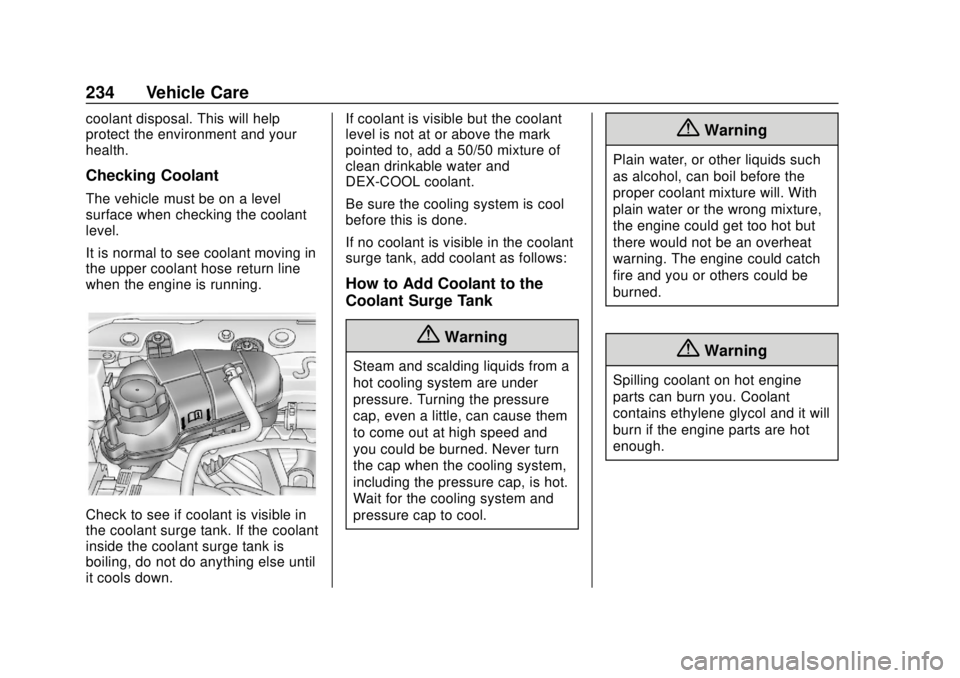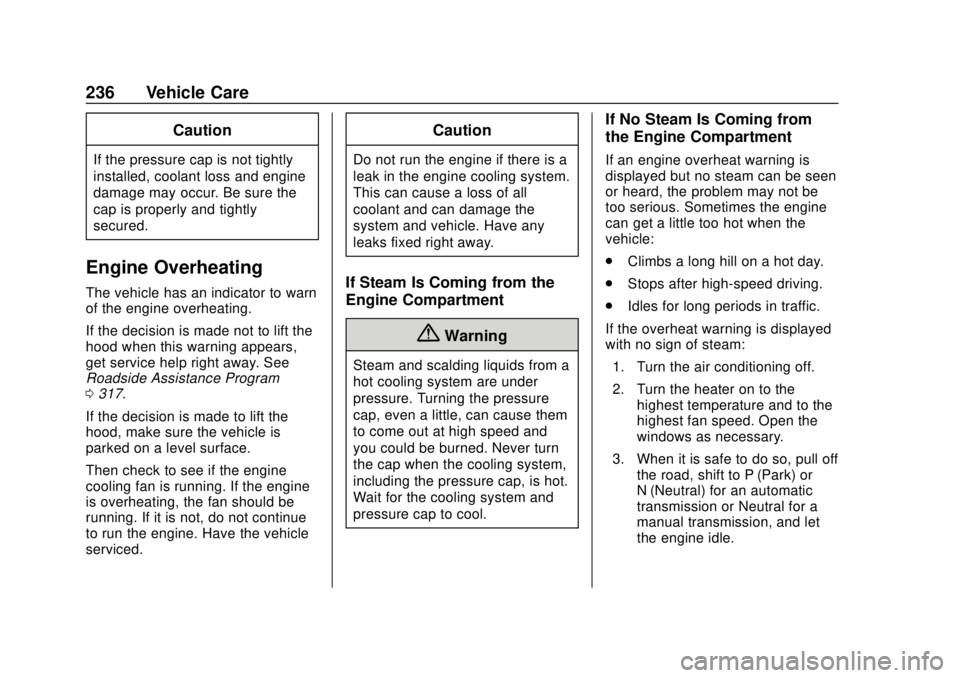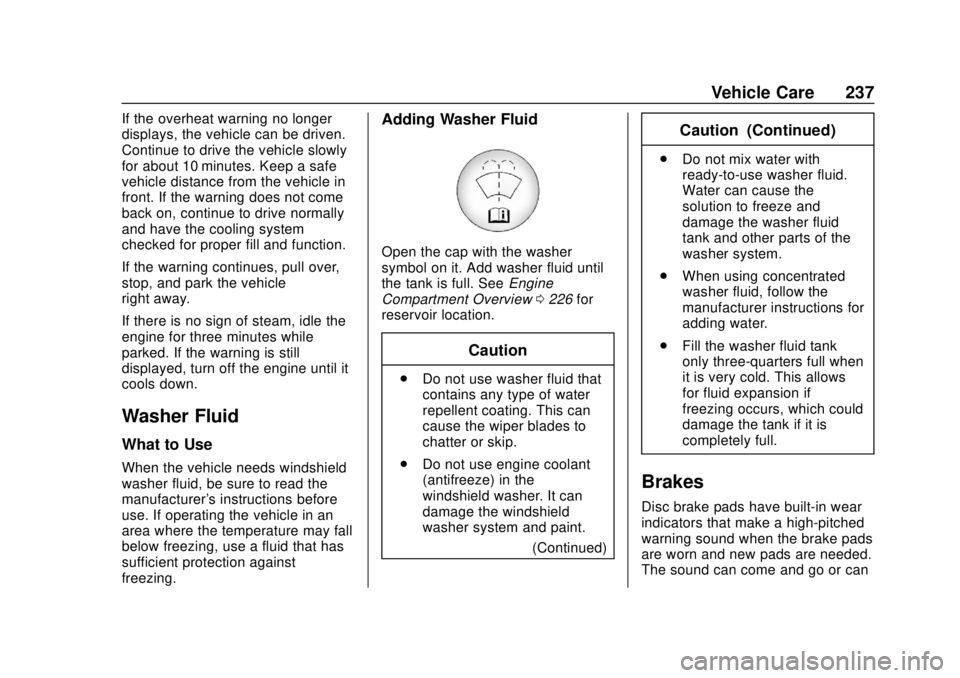2019 CHEVROLET SONIC engine overheat
[x] Cancel search: engine overheatPage 234 of 351

Chevrolet Sonic Owner Manual (GMNA-Localizing-U.S./Canada-12461769) -
2019 - crc - 5/21/18
Vehicle Care 233
Warning (Continued)
Keep hands, clothing, and tools
away from any underhood
electric fan.
{Warning
Do not touch heater or radiator
hoses, or other engine parts.
They can be very hot and can
burn you. Do not run the engine if
there is a leak; all coolant could
leak out. That could cause an
engine fire and can burn you. Fix
any leak before driving the
vehicle.
Engine Coolant
The cooling system in the vehicle is
filled with DEX-COOL engine
coolant. This coolant is designed to
remain in the vehicle for 5 years or
240 000 km (150,000 mi), whichever
occurs first.The following explains the cooling
system and how to check and add
coolant when it is low. If there is a
problem with engine overheating,
see
Engine Overheating 0236.
What to Use
{Warning
Plain water, or other liquids such
as alcohol, can boil before the
proper coolant mixture will. With
plain water or the wrong mixture,
the engine could get too hot but
there would not be an overheat
warning. The engine could catch
fire and you or others could be
burned.
Use a 50/50 mixture of clean
drinkable water and DEX-COOL
coolant. This mixture:
. Gives freezing protection down
to−37 °C (−34 °F), outside
temperature. .
Gives boiling protection up to
129 °C (265 °F), engine
temperature.
. Protects against rust and
corrosion.
. Will not damage aluminum parts.
. Helps keep the proper engine
temperature.Caution
Do not use anything other than a
mix of DEX-COOL coolant that
meets GM Standard
GMW3420 and clean, drinkable
water. Anything else can cause
damage to the engine cooling
system and the vehicle, which
would not be covered by the
vehicle warranty.
Never dispose of engine coolant by
putting it in the trash, pouring it on
the ground, or into sewers, streams,
or bodies of water. Have the coolant
changed by an authorized service
center, familiar with legal
requirements regarding used
Page 235 of 351

Chevrolet Sonic Owner Manual (GMNA-Localizing-U.S./Canada-12461769) -
2019 - crc - 5/21/18
234 Vehicle Care
coolant disposal. This will help
protect the environment and your
health.
Checking Coolant
The vehicle must be on a level
surface when checking the coolant
level.
It is normal to see coolant moving in
the upper coolant hose return line
when the engine is running.
Check to see if coolant is visible in
the coolant surge tank. If the coolant
inside the coolant surge tank is
boiling, do not do anything else until
it cools down.If coolant is visible but the coolant
level is not at or above the mark
pointed to, add a 50/50 mixture of
clean drinkable water and
DEX-COOL coolant.
Be sure the cooling system is cool
before this is done.
If no coolant is visible in the coolant
surge tank, add coolant as follows:
How to Add Coolant to the
Coolant Surge Tank
{Warning
Steam and scalding liquids from a
hot cooling system are under
pressure. Turning the pressure
cap, even a little, can cause them
to come out at high speed and
you could be burned. Never turn
the cap when the cooling system,
including the pressure cap, is hot.
Wait for the cooling system and
pressure cap to cool.
{Warning
Plain water, or other liquids such
as alcohol, can boil before the
proper coolant mixture will. With
plain water or the wrong mixture,
the engine could get too hot but
there would not be an overheat
warning. The engine could catch
fire and you or others could be
burned.
{Warning
Spilling coolant on hot engine
parts can burn you. Coolant
contains ethylene glycol and it will
burn if the engine parts are hot
enough.
Page 236 of 351

Chevrolet Sonic Owner Manual (GMNA-Localizing-U.S./Canada-12461769) -
2019 - crc - 5/21/18
Vehicle Care 235
Caution
Failure to follow the specific
coolant fill procedure could cause
the engine to overheat and could
cause system damage. If coolant
is not visible in the surge tank,
contact your dealer.
If no problem is found, check to see
if coolant is visible in the coolant
surge tank. If coolant is visible but
the coolant level is not at the
indicated level mark, add a 50/
50 mixture of clean, drinkable water
and DEX-COOL coolant at the
coolant surge tank, but be sure the
cooling system, including the
coolant surge tank pressure cap, is
cool before you do it.
1. Remove the coolant surge tank pressure cap when the cooling
system, including the coolant
surge tank pressure cap and
upper radiator hose, is no
longer hot.
Turn the pressure cap slowly
counterclockwise about
one-quarter of a turn. If you
hear a hiss, wait for that to
stop. This will allow any
pressure still left to be vented
out the discharge hose.
2. Keep turning the pressure cap slowly and remove it.3. Fill the coolant surge tank withthe proper mixture to the
indicated level mark.
4. With the coolant surge tank pressure cap off, start the
engine and let it run until you
can feel the upper radiator
hose getting hot. Watch out for
the engine cooling fan.
By this time, the coolant level
inside the coolant surge tank
may be lower. If the level is
lower, add more of the proper
mixture to the coolant surge
tank until the level reaches the
indicated level mark.
5. Replace the pressure cap tightly.
Check the level in the coolant surge
tank when the cooling system has
cooled down. If the coolant is not at
the proper level, repeat Steps 1–
3 and reinstall the pressure cap.
If the coolant still is not at the proper
level when the system cools down
again, see your dealer.
Page 237 of 351

Chevrolet Sonic Owner Manual (GMNA-Localizing-U.S./Canada-12461769) -
2019 - crc - 5/21/18
236 Vehicle Care
Caution
If the pressure cap is not tightly
installed, coolant loss and engine
damage may occur. Be sure the
cap is properly and tightly
secured.
Engine Overheating
The vehicle has an indicator to warn
of the engine overheating.
If the decision is made not to lift the
hood when this warning appears,
get service help right away. See
Roadside Assistance Program
0317.
If the decision is made to lift the
hood, make sure the vehicle is
parked on a level surface.
Then check to see if the engine
cooling fan is running. If the engine
is overheating, the fan should be
running. If it is not, do not continue
to run the engine. Have the vehicle
serviced.
Caution
Do not run the engine if there is a
leak in the engine cooling system.
This can cause a loss of all
coolant and can damage the
system and vehicle. Have any
leaks fixed right away.
If Steam Is Coming from the
Engine Compartment
{Warning
Steam and scalding liquids from a
hot cooling system are under
pressure. Turning the pressure
cap, even a little, can cause them
to come out at high speed and
you could be burned. Never turn
the cap when the cooling system,
including the pressure cap, is hot.
Wait for the cooling system and
pressure cap to cool.
If No Steam Is Coming from
the Engine Compartment
If an engine overheat warning is
displayed but no steam can be seen
or heard, the problem may not be
too serious. Sometimes the engine
can get a little too hot when the
vehicle:
. Climbs a long hill on a hot day.
. Stops after high-speed driving.
. Idles for long periods in traffic.
If the overheat warning is displayed
with no sign of steam: 1. Turn the air conditioning off.
2. Turn the heater on to the highest temperature and to the
highest fan speed. Open the
windows as necessary.
3. When it is safe to do so, pull off the road, shift to P (Park) or
N (Neutral) for an automatic
transmission or Neutral for a
manual transmission, and let
the engine idle.
Page 238 of 351

Chevrolet Sonic Owner Manual (GMNA-Localizing-U.S./Canada-12461769) -
2019 - crc - 5/21/18
Vehicle Care 237
If the overheat warning no longer
displays, the vehicle can be driven.
Continue to drive the vehicle slowly
for about 10 minutes. Keep a safe
vehicle distance from the vehicle in
front. If the warning does not come
back on, continue to drive normally
and have the cooling system
checked for proper fill and function.
If the warning continues, pull over,
stop, and park the vehicle
right away.
If there is no sign of steam, idle the
engine for three minutes while
parked. If the warning is still
displayed, turn off the engine until it
cools down.
Washer Fluid
What to Use
When the vehicle needs windshield
washer fluid, be sure to read the
manufacturer's instructions before
use. If operating the vehicle in an
area where the temperature may fall
below freezing, use a fluid that has
sufficient protection against
freezing.
Adding Washer Fluid
Open the cap with the washer
symbol on it. Add washer fluid until
the tank is full. SeeEngine
Compartment Overview 0226 for
reservoir location.
Caution
. Do not use washer fluid that
contains any type of water
repellent coating. This can
cause the wiper blades to
chatter or skip.
. Do not use engine coolant
(antifreeze) in the
windshield washer. It can
damage the windshield
washer system and paint.
(Continued)
Caution (Continued)
.Do not mix water with
ready-to-use washer fluid.
Water can cause the
solution to freeze and
damage the washer fluid
tank and other parts of the
washer system.
. When using concentrated
washer fluid, follow the
manufacturer instructions for
adding water.
. Fill the washer fluid tank
only three-quarters full when
it is very cold. This allows
for fluid expansion if
freezing occurs, which could
damage the tank if it is
completely full.
Brakes
Disc brake pads have built-in wear
indicators that make a high-pitched
warning sound when the brake pads
are worn and new pads are needed.
The sound can come and go or can
Page 343 of 351

Chevrolet Sonic Owner Manual (GMNA-Localizing-U.S./Canada-12461769) -
2019 - crc - 5/21/18
342 Index
Driving (cont'd)Loss of Control . . . . . . . . . . . . . . . 178
Off-Road Recovery . . . . . . . . . . . 177
Vehicle Load Limits . . . . . . . . . . . 181
Wet Roads . . . . . . . . . . . . . . . . . . . 178
Winter . . . . . . . . . . . . . . . . . . . . . . . . 180
E
Electrical Equipment,
Add-On . . . . . . . . . . . . . . . . . . . . . . . 219
Electrical System Engine Compartment FuseBlock . . . . . . . . . . . . . . . . . . . . . . . . 249
Fuses and Circuit Breakers . . . 248
Instrument Panel Fuse
Block . . . . . . . . . . . . . . . . . . . . . . . . 251
Overload . . . . . . . . . . . . . . . . . . . . . 248
Emergency OnStar . . . . . . . . . . . . . . . . . . . . . . . 328
Engine Air Cleaner/Filter . . . . . . . . . . . . . 231
Check Light (MalfunctionIndicator) . . . . . . . . . . . . . . . . . . . . .116
Compartment Overview . . . . . . . 226
Coolant Temperature
Warning Light . . . . . . . . . . . . . . . 122
Cooling System . . . . . . . . . . . . . . . 232
Drive Belt Routing . . . . . . . . . . . . 312 Engine (cont'd)
Exhaust . . . . . . . . . . . . . . . . . . . . . . 195
Heater . . . . . . . . . . . . . . . . . . . . . . . . 191
Oil Life System . . . . . . . . . . . . . . . 229
Oil Pressure Light . . . . . . . . . . . . 123
Overheating . . . . . . . . . . . . . . . . . . 236
Power Messages . . . . . . . . . . . . . 131
Reduced Power Light . . . . . . . . . 124
Running While Parked . . . . . . . . 196
Starting . . . . . . . . . . . . . . . . . . . . . . . 189
Entry Lighting . . . . . . . . . . . . . . . . . . . 140
Event Data Recorders . . . . . . . . . . 325
Exit Lighting . . . . . . . . . . . . . . . . . . . . 140
Extended Parking . . . . . . . . . . . . . . . 195
Extender, Seat Belt . . . . . . . . . . . . . . 68
Exterior Lamp Controls . . . . . . . . . 135
Exterior Lighting Battery Saver . . . . . . . . . . . . . . . . . . . . . . . . . 141
F
Filter,
Engine Air Cleaner . . . . . . . . . . . 231
Flash-to-Pass . . . . . . . . . . . . . . . . . . . 136
Flashers, Hazard Warning . . . . . . 137
Flat Tire . . . . . . . . . . . . . . . . . . . . . . . . 272 Changing . . . . . . . . . . . . . . . . . . . . . 274
Floor Mats . . . . . . . . . . . . . . . . . . . . . . 293 Fluid
Automatic Transmission . . . . . . 230
Brakes . . . . . . . . . . . . . . . . . . . . . . . . 238
Washer . . . . . . . . . . . . . . . . . . . . . . . 237
Fog Lamps . . . . . . . . . . . . . . . . . . . . . 138
Folding Mirrors . . . . . . . . . . . . . . . . . . 49
Forward Collision Alert (FCA) System . . . . . . . . . . . . . . . . . 212
Forward Collision Alert (FCA) Warning Light . . . . . . . . . . 120
Frequency Statement
Radio . . . . . . . . . . . . . . . . . . . . . . . . . 323
Front Fog Lamp Light . . . . . . . . . . . . . . . . . . . . . . . . . . 124
Front Seat Armrest . . . . . . . . . . . . . . 59
Front Seats Adjustment . . . . . . . . . . . . . . . . . . . . . 56
Heated . . . . . . . . . . . . . . . . . . . . . . . . . 59
Fuel Additives . . . . . . . . . . . . . . . . . . . . . 217
Economy Driving . . . . . . . . . . . . . . . 25
Filling a Portable FuelContainer . . . . . . . . . . . . . . . . . . . 218
Filling the Tank . . . . . . . . . . . . . . . 217
Foreign Countries . . . . . . . . . . . . 217
Gauge . . . . . . . . . . . . . . . . . . . . . . . . .113
Low Fuel Warning Light . . . . . . . 123
Prohibited Fuels . . . . . . . . . . . . . . 216
Page 346 of 351

Chevrolet Sonic Owner Manual (GMNA-Localizing-U.S./Canada-12461769) -
2019 - crc - 5/21/18
Index 345
M
MaintenanceRecords . . . . . . . . . . . . . . . . . . . . . . 308
Maintenance and Care Additional . . . . . . . . . . . . . . . . . . . . . 303
Maintenance Schedule . . . . . . . . . 297 Recommended Fluids andLubricants . . . . . . . . . . . . . . . . . . . 306
Malfunction Indicator Lamp . . . . . 116
Manual Mirrors . . . . . . . . . . . . . . . . . . 49
Manual Mode . . . . . . . . . . . . . . . . . . . 198
Manual Transmission . . . . . . . . . . . 199 Fluid . . . . . . . . . . . . . . . . . . . . . . . . . . 231
Manual Windows . . . . . . . . . . . . . . . . 50
Media
Avoiding Untrusted Devices . . 150
Messages Engine Power . . . . . . . . . . . . . . . . 131
Vehicle . . . . . . . . . . . . . . . . . . . . . . . 130
Vehicle Speed . . . . . . . . . . . . . . . . 132
Mirrors Convex . . . . . . . . . . . . . . . . . . . . . . . . . 48
Folding . . . . . . . . . . . . . . . . . . . . . . . . . 49
Heated . . . . . . . . . . . . . . . . . . . . . . . . . 49
Manual . . . . . . . . . . . . . . . . . . . . . . . . . 49
Manual Rearview . . . . . . . . . . . . . . . 50
Power . . . . . . . . . . . . . . . . . . . . . . . . . . 49 Monitor System, Tire
Pressure . . . . . . . . . . . . . . . . . . . . . . 261
Multi-band Antenna . . . . . . . . . . . . . 150
N
Navigation Connected Services . . . . . . . . . . 335
New Vehicle Break-In . . . . . . . . . . . 185
O
Odometer . . . . . . . . . . . . . . . . . . . . . . . 113 Trip . . . . . . . . . . . . . . . . . . . . . . . . . . . .113
Off-Road
Recovery . . . . . . . . . . . . . . . . . . . . . 177
Oil Engine . . . . . . . . . . . . . . . . . . . . . . . . 227
Engine Oil Life System . . . . . . . 229
Pressure Light . . . . . . . . . . . . . . . . 123
Older Children, Restraints . . . . . . . 82
Online Owner Center . . . . . . . . . . . 316
OnStar . . . . . . . . . . . . . . . . . . . . . . . . . 326
OnStar Additional Information . . . . . . . . . . . . . . . . . . . . 329
OnStar Emergency . . . . . . . . . . . . . 328
OnStar Overview . . . . . . . . . . . . . . . 327
OnStar Security . . . . . . . . . . . . . . . . 329
OnStar System . . . . . . . . . . . . . . . . . 155
Operate Pedal Light . . . . . . . . . . . . 119 Operation
Fog Lamps . . . . . . . . . . . . . . . . . . . 138
Outlets Power . . . . . . . . . . . . . . . . . . . . . . . . 109
Overheating, Engine . . . . . . . . . . . . 236
Overview . . . . . . . . . . . . . . . . . . . . . . . 143
Owner Manual Indicator . . . . . . . . 118
P
Park Shifting Into . . . . . . . . . . . . . . . . . . . 193
Shifting Out of . . . . . . . . . . . . . . . . 194
Park Assist . . . . . . . . . . . . . . . . . . . . . 211
Parking . . . . . . . . . . . . . . . . . . . . . . . . . 194 Brake . . . . . . . . . . . . . . . . . . . . . . . . . 202
Brake and P (Park)Mechanism Check . . . . . . . . . . 241
Extended . . . . . . . . . . . . . . . . . . . . . 195
Over Things That Burn . . . . . . . 195
Ultrasonic Sensor Light . . . . . . . 121
Passenger Airbag Status
Indicator . . . . . . . . . . . . . . . . . . . . . . 115
Passenger Compartment Air Filter . . . . . . . . . . . . . . . . . . . . . . . . . . 172
Passenger Sensing System . . . . . 76
Perchlorate Materials Requirements, California . . . . . . 223